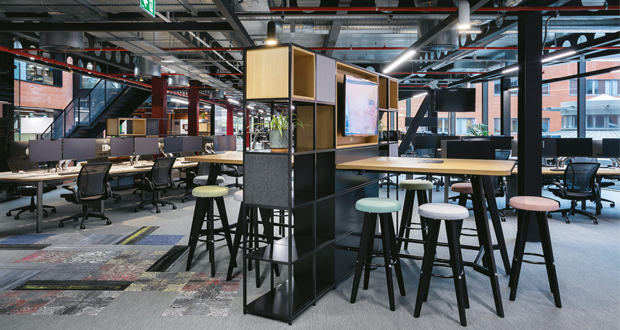Paul Edward, Managing Director of British office furniture designer and manufacturer Staverton explains why choosing flexible and mobile furniture can help employees to shape the environment to suit their needs
The pandemic, and our subsequent return to the office has made the need for high performing workspaces that deliver the best from their people, more important than ever. For FMs who are typically on the front line of translating employees’ new wants, needs and behaviours into engaging, efficient, agile, and ergonomic workspaces – there is a seismic task ahead.
To deliver this vision, workplace design is undergoing a metamorphosis. Office spaces are fast becoming hubs for collaboration and community, rather than merely head-down desk-based work, as hybrid-working becomes the new normal. And, as collaboration and teamwork are important to 75 per cent of employees and 17 per cent are more satisfied when collaboration is part of their work, recognising these needs not only supports staff productivity and wellbeing, but is crucial for talent recruitment and retention too.
With those considerations in mind it’s not surprising that flexible and mobile furniture is fast becoming a staple of the post-pandemic workplace as a vital building block that can help employees feel in control, be productive and comfortable, make space work harder for a business, and build longevity into work environments.
ACTIVITY-BASED WORKING
We broke free of our desk-based shackles some time ago and workplaces are now much more richly varied and agile places as a result – with increasingly task-based areas for coalescing, socialisation, collaboration, quiet reflection and more. Consequently, most office furniture projects have a requirement for flexible and/or mobile furniture as it enables employees to shape the environment to suit their needs. This degree of personalisation, adjustment and customisation is important – particularly when most modern workplaces are centred on shared rather than owned spaces. Plus, it can help to support more diverse employee needs and create more inclusive workplaces.
Resimercial design has been around for some time – that is the idea of bringing residential elements into the workplace – but the pandemic really accelerated this appetite for greater home comforts and design familiarity at work. After almost two years of being able to manage your own work setting – everything from heating, lighting, and location to the quality of the coffee you drink – choice is now vital in the shared workplace. That might be exercising task-related choices such as choosing a quiet pod to make a difficult phone call, changing the height of a desk to aid movement and improve wellbeing, working from the roof garden or simply grabbing a drink and socialising with colleagues.
The benefit of flexible furniture is that it can help to create spaces within spaces instead of using walls and provide visual cues as to how areas are to be used. Valuably, it can also be used numerous different ways by different people. So, a large kitchen-table can support collaborative team meetings, but it can also provide touch-down spaces for visitors when it’s not in use. Mobile sit-stand desks can be set to suit individual users’ needs and moved as tasks require while tech-rich scrum spaces can be used for informal one-to-ones just as readily as for project team updates.
While the benefits of flexibility do often centre on employees’ needs, we must remember the value this has for organisations and FMs too. The pandemic made businesses of all sizes realise just how critical the qualities of resilience, adaptability and flexibility are. In choosing flexible furniture, FMs are essentially equipping their organisations with the tools to pivot as operational needs change, working styles and patterns evolve, and teams grow or decline. Furniture that serves multiple uses, or which can be moved, reconfigured, upgraded or customised provides the latitude agile organisations require and FMs’ capex budgets need.






